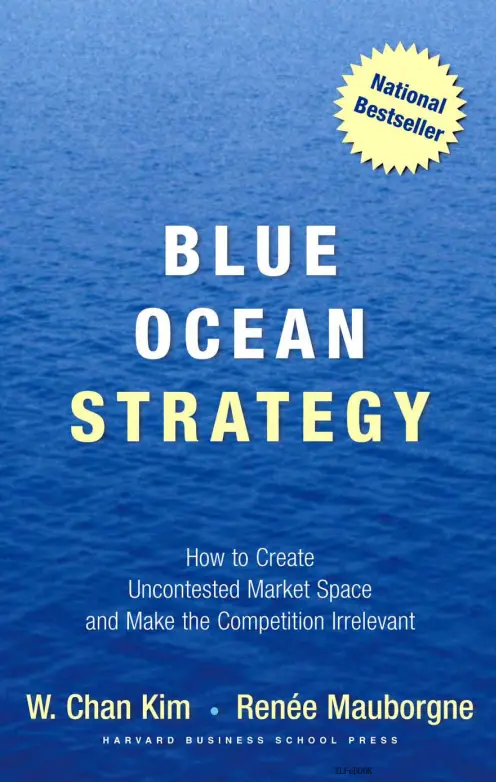
Blue Ocean Strategy teaches how to escape competition and create new market space where demand is uncontested. W. Chan Kim and Renée Mauborgne show that true innovation comes not from beating the competition, but from redefining the rules. By focusing on value innovation, companies can unlock new demand, grow profitably, and achieve long-term success.
Blue Ocean Strategy is a groundbreaking business strategy book that challenges the traditional view of competition-driven markets.
Written by INSEAD professors W. Chan Kim and Renée Mauborgne , this book introduces a new way of thinking about strategy—not by beating the competition, but by making it irrelevant .
The central idea is based on a simple but powerful metaphor:
“In red oceans, industry boundaries are defined and accepted, and the competitive rules of the game are known. In blue oceans, competition is irrelevant because the rules of the game are waiting to be set.”
This book offers a clear framework for how businesses can break free from the cutthroat world of competition and create new market space where they can thrive without fighting for scraps.
Most companies operate in red oceans —markets that are already saturated with competitors.
In these markets:
“As markets become saturated and global competition grows, companies increasingly battle for market share in shrinking profit pools.”
Kim and Mauborgne argue that competing harder in red oceans only leads to diminishing returns. Instead, businesses should focus on value innovation —creating new demand by redefining what customers value.
A blue ocean is an uncontested market space where there is no competition—only opportunity.
Examples include:
These companies didn’t beat the competition—they avoided it altogether by creating something entirely new.
“Value innovation occurs when companies align innovation with utility, simplicity, and convenience to unlock new demand.”
Key Insight: True growth lies not in battling rivals, but in creating new market space.
To successfully create a blue ocean, companies must rethink their approach to strategy using four guiding principles:
Instead of accepting industry norms, challenge them. Look across alternative industries, strategic groups, buyer segments, complementary products, emotional versus functional appeal, and trends.
Strategic moves should be guided by a compelling vision—not just spreadsheets. Use visual strategy tools like the Strategy Canvas to map your current position and explore new ones.
Don’t just target current customers—look for non-customers who have been ignored or underserved.
Follow a logical path:
Important Lesson: Blue oceans are created through strategic innovation—not luck or disruption alone.
One of the most useful tools introduced in the book is the Strategy Canvas —a visual representation of where your company stands compared to others in your industry.
It works by:
Example: Apple’s iPod didn’t just improve MP3 players—it eliminated complexity, raised design standards, and created a seamless music experience.
Key Insight: Great strategies stand out visually and emotionally—they don’t blend into the crowd.
This tool helps you break away from industry norms by questioning every assumption.
Use it to ask:
This framework encourages bold thinking and creative destruction of outdated industry logic.
Important Lesson: To create a blue ocean, stop trying to do more better—and start doing different things altogether.
Throughout the book, Kim and Mauborgne share real-world case studies that illustrate how companies broke away from the pack:
Combined elements of theater and circus to create a new form of live entertainment. Eliminated animal acts and star performers, raised storytelling and artistic value, and created a premium product for adults.
Made wine simple, fun, and accessible. Focused on taste and ease of choice instead of complex labeling and tradition.
Created a new category of air travel—low-cost, frequent flights with a fun, no-frills experience.
Turned private jet ownership into fractional access—opening up luxury travel to a broader market.
These examples show that blue oceans can be created in any industry , even mature ones.
The authors offer practical guidance for applying blue ocean thinking at any level:
Stop asking how to beat the competition. Start asking how to make the competition irrelevant.
Find inspiration outside your field. What works in one sector might transform another.
Ask: Who isn’t buying from anyone in your industry? Why not?
Don’t try to be the best—try to be unique.
Offer exceptional value at a price point that attracts mass adoption—while keeping costs low enough to generate profit.
Even the best ideas fail if people won’t adopt them. Think ahead about how to overcome adoption hurdles.
Key Insight: Blue oceans aren’t about technology innovation—they’re about strategic innovation .
Creating a blue ocean strategy requires more than just creativity—it demands leadership and organizational alignment.
Common obstacles include:
Kim and Mauborgne introduce the concept of Fair Process —engaging employees early, explaining decisions clearly, and allowing autonomy—to overcome these barriers.
“Without trust and engagement, even the best strategies will fail.”
Important Lesson: Strategy execution matters as much as strategy creation.
While both concepts aim to reshape markets, Blue Ocean Strategy differs from disruptive innovation in important ways:
You don’t need disruptive tech to create a blue ocean—you just need a fresh perspective and the courage to redefine your market.
Blue Ocean Strategy is more than a business book—it’s a mindset shift.
It teaches that:
As the authors write:
“The essence of blue ocean strategy is not about doing more for more. It’s about doing less for more value—or more for less cost.”